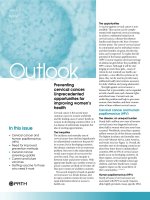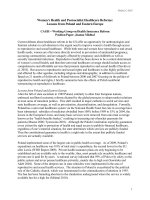Global Strategy for Women''''s and Children''''s Health : Accountability Commission follow up Recommendation 10 Global Oversight pptx
Bạn đang xem bản rút gọn của tài liệu. Xem và tải ngay bản đầy đủ của tài liệu tại đây (1.24 MB, 37 trang )
Global Strategy for Women’s and Children’s Health – Global Oversight
1
Name
Accountability Commission follow up
Recommendation 10
Global Oversight
Global Strategy for Women's and Children's Health
Global Strategy for Women’s and Children’s Health – Global Oversight
2
Name
• The UN Global Strategy for Women's
and Children's Health
September 2010
• Commission on Information and
Accountability for Women’s and
Children’s Health and Accountability
Framework of 10 Recommendations
December 2010 - May 2011
• Independent Expert Review Group
2012-2015
OUTLINE / CHRONOLOGY:
Global Strategy for Women’s and Children’s Health – Global Oversight
UN Global Strategy
• The UN Global Strategy for Women's and
Children's Health was launched in September
2010 by UN Secretary-General Ban Ki-moon
• It is a roadmap on how to enhance financing,
strengthen policy and improve service on the
ground for the most vulnerable women and
children
• It aims to save the lives of 16 million women and
children by 2015.
Global Strategy for Women’s and Children’s Health – Global Oversight
4
Name
Commission on
Information and Accountability
for Women’s and Children’s
Health
Global Strategy for Women’s and Children’s Health – Global Oversight
Commissioners
1
st
Meeting of the Commissioners, WHO HQ, Geneva, 26 January 2011
Global Strategy for Women’s and Children’s Health – Global Oversight
6
Overview of the Commission
• Called at the request of the UN Secretary-
General as an integral part of the UN Global
Strategy for Women's and Children's Health
President of Tanzania and Prime Minister of Canada
co-chair
WHO (secretariat) and ITU vice-chairs
30 Commissioners
2 Working Groups – Results and Resources
• Six month, time-limited Commission, from 26
January to 2 May 2011
Global Strategy for Women’s and Children’s Health – Global Oversight
7
Objectives of the Commission
1. Determine international institutional
arrangements for global reporting, oversight and
accountability - for results and resources - on
women's and children’s health.
2. Identify ways to improve monitoring of progress.
3. Propose actions to overcome major challenges
to accountability at the country level.
4. Identify opportunities for innovation provided by
information technology.
Global Strategy for Women’s and Children’s Health – Global Oversight
8
Accountability Framework: Key principles
• National leadership and ownership of results
• Strengthen countries’ capacity to monitor and evaluate
• Reduce the reporting burden by aligning efforts with the
systems countries use to monitor and evaluate their
national health strategies
• Strengthen and harmonize existing international
mechanisms to track progress on all commitments made
• Founded on the fundamental human right of every woman
and child to the highest attainable standard of health, and
on achieving equity in health
8
Global Strategy for Women’s and Children’s Health – Global Oversight
9
Accountability Framework: Parameters
• Applicable at all levels – national and global
• Links results and resources
• Three building blocks: Monitor, Review, Act
• All partners accountable for the commitments
they make and the health policies and
programmes they design and implement.
• Builds on and strengthens existing mechanisms
9
Global Strategy for Women’s and Children’s Health – Global Oversight
10
Commission: key outcomes
• Final Report Keeping Promises, Measuring Results:
- Accountability Framework
- 10 actionable Recommendations
• Request to WHO to lead implementation
• Advance Copy of Report released at a Technical
Briefing (19 May) at the WHA
• Release by UN SG in New York on 20 September
2011
Global Strategy for Women’s and Children’s Health – Global Oversight
11
Name
Accountability Framework:
10 Recommendations
Global Strategy for Women’s and Children’s Health – Global Oversight
12
Accountability Framework: Visual Representation
12
Global Strategy for Women’s and Children’s Health – Global Oversight
13
Commission’s 10 Recommendations
Holding all stakeholders accountable
• Recommendations 1-3: Better information for
better results
• Recommendations 4-6: Better tracking of
resources for women's and children's health
• Recommendations 7-10: Better oversight of
results and resources: nationally and globally
13
Global Strategy for Women’s and Children’s Health – Global Oversight
14
Better information for better results
1. Vital events: By 2015, all countries have
taken significant steps to establish a system
for registration of births, deaths and causes
of death, and have well-functioning health
information systems that combine data from
facilities, administrative sources and surveys.
14
Global Strategy for Women’s and Children’s Health – Global Oversight
15
Better information for better results
15
2. Health indicators: By 2012, the same 11
indicators on reproductive, maternal and
child health, disaggregated for gender and
other equity considerations, are being used
for the purpose of monitoring progress
towards the goals of the Global Strategy.
Global Strategy for Women’s and Children’s Health – Global Oversight
16
Better information for better results
16
Eleven indicators
• Three tracer indicators:
– maternal mortality ratio
– under-5 child mortality (with the proportion of newborn deaths)
– children under 5 who are stunted
• Eight coverage indicators:
– met need for contraception
– antenatal care coverage
– antiretroviral prophylaxis among HIV positive pregnant women to
prevent mother-to-child transmission of HIV
– skilled attendant at birth
– postnatal care (within 48 hours of childbirth) for mother and child
– breastfeeding exclusively for 6 months
– three doses of the combined diphtheria, pertussis and tetanus vaccine
– children with suspected pneumonia receiving antibiotics.
Global Strategy for Women’s and Children’s Health – Global Oversight
17
Better information for better results
3. Innovation: By 2015, all countries have
integrated the use of Information and
Communication Technologies in their
national health information systems and
health infrastructure.
17
Global Strategy for Women’s and Children’s Health – Global Oversight
18
Better tracking of resources
4. Resource tracking: By 2015, all 74 countries
where 98% of maternal and child deaths take
place are tracking and reporting, at a
minimum, two aggregate resource indicators:
(i) total health expenditure by financing
source, per capita; and (ii) total reproductive,
maternal, newborn and child health
expenditure by financing source, per capita.
18
Global Strategy for Women’s and Children’s Health – Global Oversight
19
Better tracking of resources
5. Country Compacts: By 2012, in order to
facilitate resource tracking, “compacts”
between country governments and all major
development partners are in place that
require reporting, based on a format to be
agreed in each country, on externally funded
expenditures and predictable commitments.
19
Global Strategy for Women’s and Children’s Health – Global Oversight
20
Better tracking of resources
6. Reaching women and children: By 2015, all
governments have the capacity to regularly
review health spending (including spending
on reproductive, maternal, newborn and
child health) and to relate spending to
commitments, human rights, gender and
other equity goals and results.
20
Global Strategy for Women’s and Children’s Health – Global Oversight
21
Better oversight of results and resources
7. National oversight: By 2012, all countries
have established national accountability
mechanisms that are transparent, that are
inclusive of all stakeholders, and that
recommend remedial action, as required.
21
Global Strategy for Women’s and Children’s Health – Global Oversight
22
Better oversight of results and resources
8. Transparency: By 2013, all stakeholders are
publicly sharing information on commitments,
resources provided and results achieved
annually, at both national and international
levels.
22
Global Strategy for Women’s and Children’s Health – Global Oversight
23
Better oversight of results and resources
9. Reporting aid for women’s and children’s
health: By 2012, development partners
request the OECD-DAC to agree on how to
improve the Creditor Reporting System so
that it can capture, in a timely manner, all
reproductive, maternal, newborn and child
health spending by development partners. In
the interim, development partners and the
OECD implement a simple method for
reporting such expenditure.
23
Global Strategy for Women’s and Children’s Health – Global Oversight
24
Better oversight of results and resources
10. Global oversight: Starting in 2012 and
ending in 2015, an independent Expert
Review Group is reporting regularly to the
United Nations Secretary-General on the
results and resources related to the Global
Strategy and on progress in implementing
this Commission’s recommendations.
24
Global Strategy for Women’s and Children’s Health – Global Oversight
25
Name
Independent Expert Review Group









